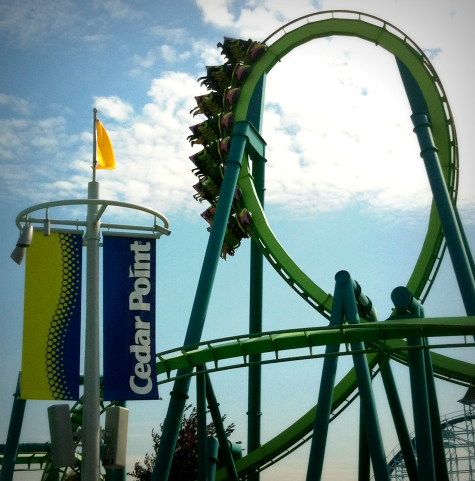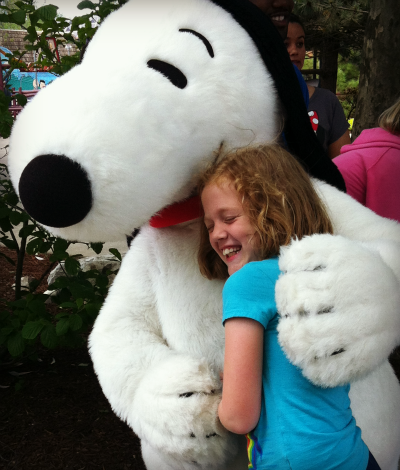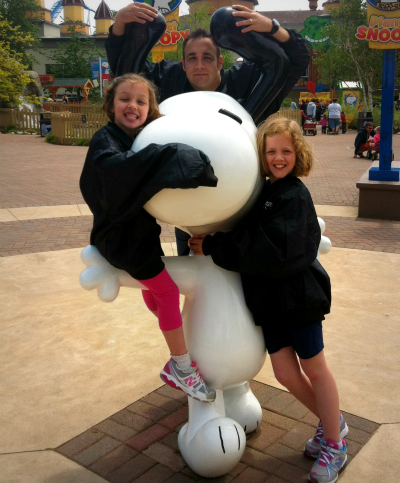There are some places we can visit over and over and still feel like it’s new and exciting every single time. Cedar Point is definitely one of those places. We made the trip to Sandusky last weekend (Cedar Point provided tickets for us) to see what’s new for 2013, and to revisit some of our old favorites.
Mira was especially hopeful that she had grown enough since last October to meet the 48″ requirement for many of the roller coasters. Last year she measured 46″ which only let her on one big coaster, the Iron Dragon.
The changes at Cedar Point start right when you get to the gate. They’ve completely remodeled the entrance now, partially to work in the newest coaster, the GateKeeper. It’s an impressive winged coaster – meaning the cars are attached to the track in the middle, but riders sit on either side on the “wings” of the coaster. There are two keyholes built into the towers around the new gate, and the GateKeeper coaster glides through each of those narrow keyholes, twisting at the last possible second to fit the arms and legs of it’s passengers safely through, and wowing visitors as they come up to the gate. It holds records for being the longest, fastest and tallest wing coaster. I can already tell you I love this coaster, and I haven’t even had a chance to ride it yet.
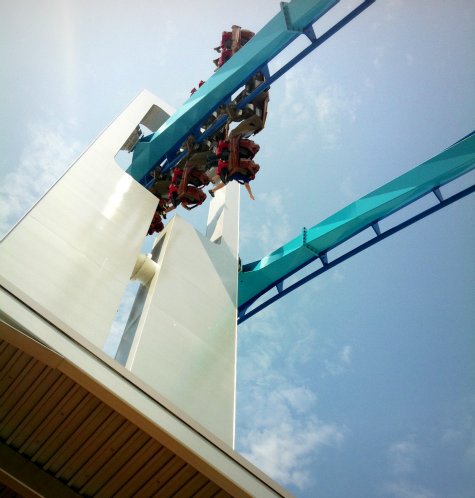 Yes, they have to turn sideways quickly to fit through that narrow tower over the main entrance to the park. It’s amazing to watch.
Yes, they have to turn sideways quickly to fit through that narrow tower over the main entrance to the park. It’s amazing to watch.
Our first stop was to get both kids measured for rides. You can do this right at the entrance and get a colored wrist band, avoiding any further waits in line to be measured again. Cordy was 54″ this time, allowing her to ride nearly everything in the park (allowing is different than wanting, though, and her anxiety kept her away from all coasters), and Mira let out a cheer when she was told she met the 48″ height requirement. She was the happiest kid ever to get her 48″ rider wristband.
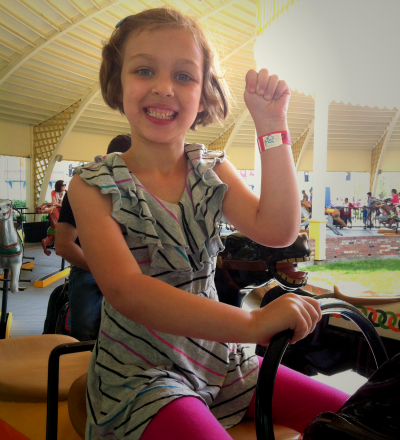 Proudly showing off her red 48″ wristband.
Proudly showing off her red 48″ wristband.
The first ride for us has practically become a tradition now. Cedar Downs is always our first stop – it’s essentially a carousel, but it goes faster than most, and the horses “race” each other, with one in each row coming out ahead by the end of the ride. (The winner varies each time.) Cordy loves this ride, and Mira was thrilled to have her first experience with it.
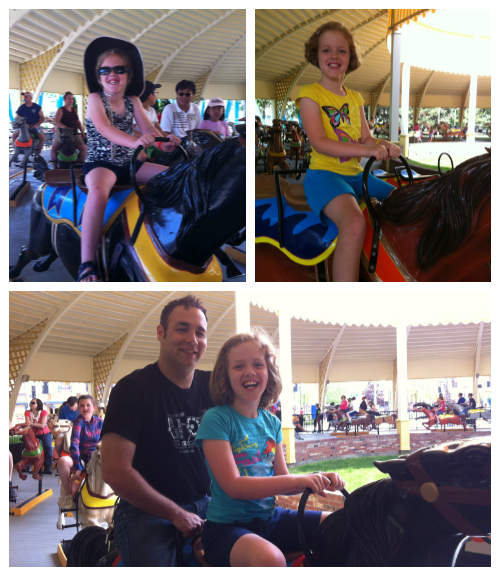 Cordy on Cedar Downs: 2011, 2012, 2013 (with Aaron this time)
Cordy on Cedar Downs: 2011, 2012, 2013 (with Aaron this time)
After that we had a quick lunch (full disclosure: lunch was provided by Cedar Point) and Aaron was so happy that Cedar Point is considerate of those with food allergies. He was able to eat a gluten-free pizza for lunch, with other gluten-free options available as well. If you need a gluten-free meal, try Joe Cool Cafe – they even have separate fryers for those who can’t have gluten but still want some french fries or gluten-free chicken tenders.
Mira then wanted to continue exploiting her new height to ride another 48″ or higher ride. Off to the Cedar Creek Mine Ride we went! Cordy used to love this ride, but her anxiety was too high, so she stayed back. Thankfully, Cedar Point offers a Parent Swap pass for this kind of situation. You can pick up a Parent Swap pass in the Guest Services office, good for one use on most of the larger rides.
Here’s how it works: one parent gets in line for the ride with their child, while the other parent does something else with the kid who doesn’t want to ride. Once the first parent and child get off the ride, they hand the Parent Swap pass to an attendant and go out the exit. The other parent can trade off and go up the exit ramp to get on the ride with no wait. Each parent gets to ride, and the child who wants to ride gets to do it twice. It’s a win-win.
Mira loved the Mine Ride! We tried the Gemini next, which was a little more scary for her. I’m glad she decided not to try Millennium Force quite yet. At this point we decided to dial back the adventure level a little and spend some time in Camp Snoopy, which is filled with rides for the younger set. (Although many allow adults to ride with their kids, too.) Cordy was a big fan of the Tilt-a-Whirl, and we rode that ride at least five times. Yes, I’m still dizzy.
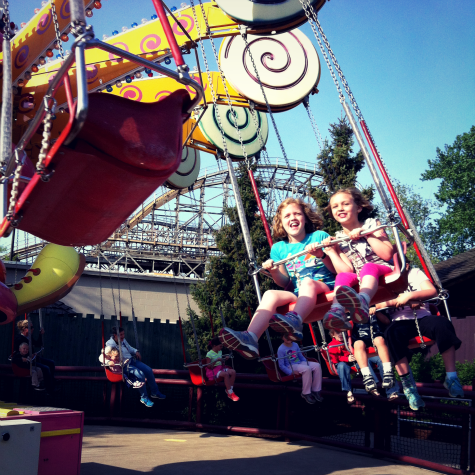 Cordy and Mira took a few rides on the swings, too.
Cordy and Mira took a few rides on the swings, too.
You can also meet Snoopy and his Peanuts friends in Camp Snoopy. Cordy couldn’t miss out on a hug.
We like playing the carnival games at Cedar Point, too, always coming home with some new stuffed animals to add to the family of plush creatures. Both kids like that Pokemon can often be found as prizes with some of the games, but Cordy set her sights higher this year:
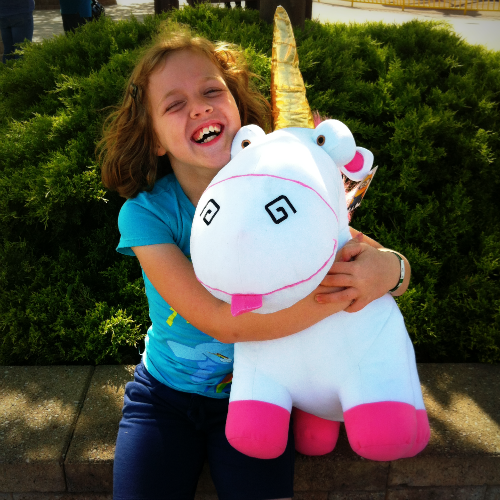 Say it with me, folks: IT’S SO FLUFFY!
Say it with me, folks: IT’S SO FLUFFY!
Near the end of the day, Mira got her courage back and asked to go on the Corkscrew. This roller coaster has three loops in it – I thought there was no way she’d want to go on a looping coaster. But she did, and she waited with Aaron patiently (although nervously) in line for the ride. Despite the wristband, they still checked her height again – she just barely clears 48″ and I think they were surprised a five year old wanted on the Corkscrew.
She did it, though – and she loved it! I know Mira is going to be a Cedar Point Ride Warrior as she gets older. She’s already asking how long it will take for her to be 52″ tall so she can ride Top Thrill Dragster, a ride that goes from zero to 120 miles-per-hour in four seconds. Maybe she can ride that one with her dad.
This is our third year in a row to go to Cedar Point, and we really appreciate how much there is to do in this amusement park. We love how many thrill rides are in this park, as well as plenty of family rides and in-between rides that are thrilling but not too scary. Our energy level ran out before we ran out of rides and attractions to visit – you can’t do it all in a day!
Yes, we love Disney World and will always love Disney World, but Disney’s roller coasters can’t compare to the roller coasters at Cedar Point. And unlike Disney, Cedar Point is an Ohio theme park that’s easy to daytrip or take a short Ohio staycation at Lake Erie.
If you have the chance, get to Cedar Point to try the new GateKeeper this year, and then let me know how you liked it! I’m hoping we’ll visit again later this summer, perhaps with more adults in our group, so Aaron and I can take a ride on GateKeeper together!
Full disclosure: I was invited by Cedar Point to bring my family to the park for the day and received complimentary admission into the park and lunch. Mira’s blossoming Ride Warrior personality comes to her naturally – both of her parents love roller coasters!
